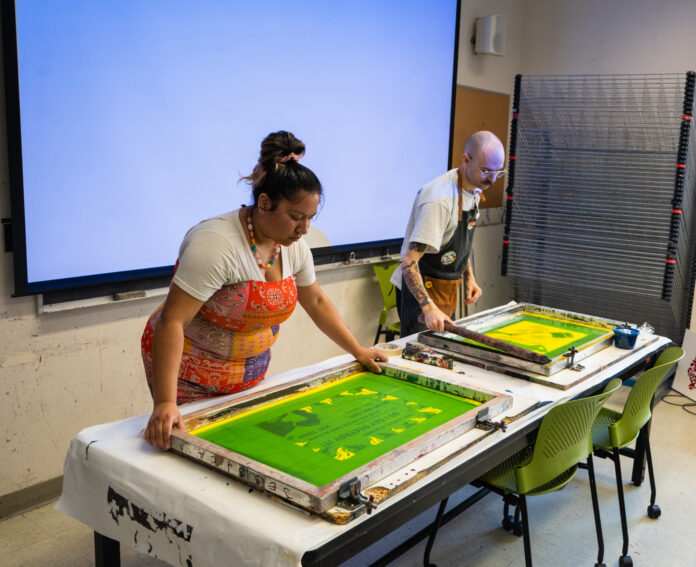Students share their experiences and screenprint concepts from winter 2025
By EVELYN SANCHEZ — features@theaggie.org
Located in the heart of Hart Hall, one unique classroom on the UC Davis campus has a closet full of paint buckets and tape. Colorful posters line the walls and wire drying racks reach the ceiling to store the student-created posters. The three-hour-long class might be tiring, but the skills it gives to students are invaluable.
Not restricted to just Chicana/Chicano studies majors, the CHI 172: Chicana/o Voice/Poster Silk Screen Workshop course presents students with a quarter-long opportunity to screen print posters in the traditional way. The art form has recently gravitated toward the digital interface, but Professor Gilda Posada provides students with the opportunity to engage with a historically political art medium by utilizing the techniques used since the 1960s.
For most students, the class presents a completely new and unique experience.
“I picked this class because it was a good outlet,” Devin Bangayan, a second-year design major, said. “[Screen printing] is a technique I haven’t learned before. In design, there’s a lot of computer and digital work, and working in [physical] layers for print [was new].”
Bangayan was previously in the military and used his experiences while enlisted to cite inspiration for his poster.
“There’s a big culture around alcoholism and I wanted to talk about that,” Bangayan said. “[This poster] is a healing piece to put out there because it’s something I know a lot of people have dealt with, and I want to represent it in an understandable way.”
Gilda Posada, the current instructor for CHI 172, shared about the history of the course.
“The silk screen courses in Chicana/o/x Studies have been taught in the Department since 1989,” Posada said. ”I am the third instructor to have taught this course after Malaquias Montoya and Carlos Jackson.”
Posada began silk screen printing when she took the same class herself as a Davis undergraduate student. She received a Bachelor of Arts degree in Chicana/Chicano studies and comparative literature at UC Davis and later received a Master of Arts and Master of Fine Arts in social practice and visual critical studies at the California College of the Arts. Currently, she is working on finishing her Ph.D. at Cornell University as an all but dissertation candidate in art history and visual studies.
Her disciplines and mediums extend to digital textiles, screen printing, exhibition curation and critical art historical writing.
“I have been printing for 18 years now,” Posada said. “I very much enjoy passing down this method to students who continue to use it to uplift their communities through their messages in their art.”
The structure of the class revolves around the creation of three posters. Silk screen printing, in the way Posada teaches it, involves the manual cutting of a stencil, which is then coated in emulsion and exposed to a screen, after which the ink is pushed through a screen by a squeegee and repeated for each new additional color.
For simplicity’s sake, the students’ first posters only have one layer and one color. Every following poster becomes more complicated and adds a new layer and resulting color, adding dimension and expanding students’ limits with the medium.
Bangayan’s poster had a rich selection of colors that featured a beer bottle tipping over into a splash silhouette of a saluting soldier. The bottle read “Coping Isn’t Healing” and the splash had blocky, red letters that said “Life Over Career.”
“I kind of expected a good measure of artwork and making stuff politically related, but I didn’t think I’d make as many friends or feel comfortable being the only Black person in the class,” Faderera Popoola, a fourth-year African American studies major, said.
Popoola’s first poster focused on Diversity, Equity and Inclusion and other systems being taken away or threatened by current legislation. She remarked that she found inspiration in previous posters that said “I Am a Man” used during the civil rights movement and experimented with the phrase by substituting it for “I am Employable.”
“I wanted to play off that saying by saying ‘I am Employable’ to say that however I look or come across, I am employable,” Popoola said.
Her poster featured a Black woman with loose, 4D hair and hoop earrings holding a sign that read “I am Employable” where the only color used was black. The hair was textured by filling in the silhouette with ink and before letting it dry fully, Popoola used a scrunched-up tissue to imprint the soft fabric onto the plastic, resulting in a hair-like texture.
Adding texture to a screenprint poster is always challenging due to the plastic stencil it must be drawn — or rather, cut — onto, but Popoola used her creativity to fashion a memorable solution.
“To me [the poster subject’s attire] is professional, but to others it is not,” Popoola said. “[She] is not necessarily me but just the Black person. Regardless of what you’re wearing, you’re still employable.”
Posada also explained the roots of the course stemming from the civil rights movement.
“The course is rooted in a long history of community social art praxis that Chicana/o/x artists and many other [Black, Indigenous, and People of Color] (BIPOC) artists used to achieve liberation and social justice for their communities during the civil rights movement,” Posada said. “In the course I continue to uphold those histories, rooted in visualizing ideas that seek to create a better world, while responding to the present moment with a new generation of artists.”
BIPOC students in the class are not only able to depict personal and meaningful ideas but, in doing so, also call back to a tradition that is ingrained within their histories. The course is open to students of all years and majors and provides a special creative opportunity for interested parties to demonstrate their political voice through art.
Written by: Evelyn Sanchez — features@theaggie.org





